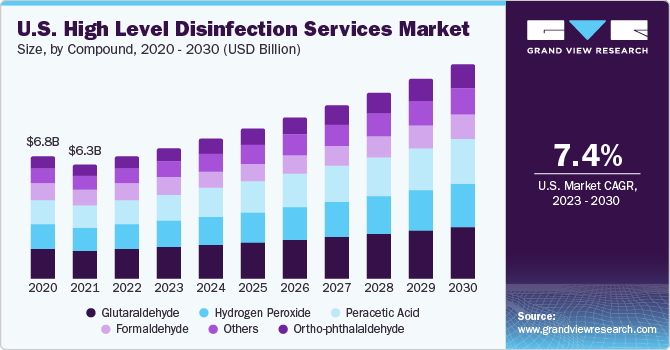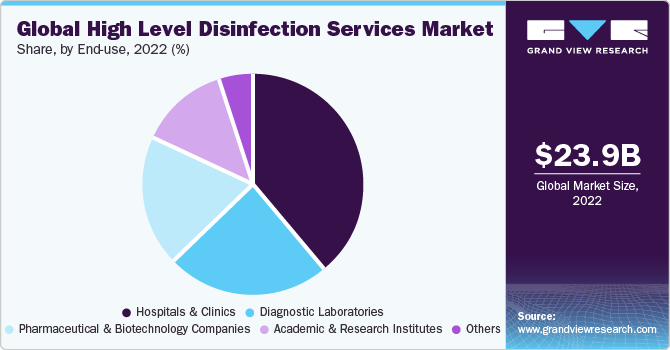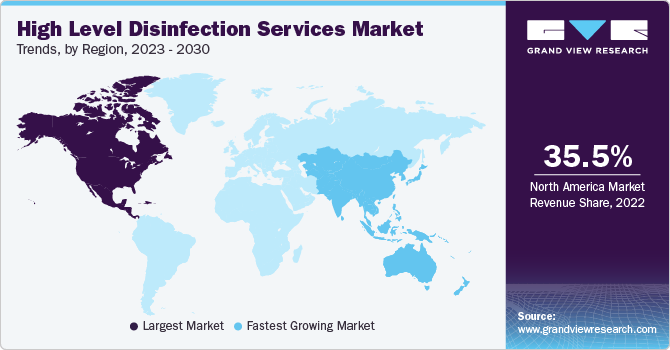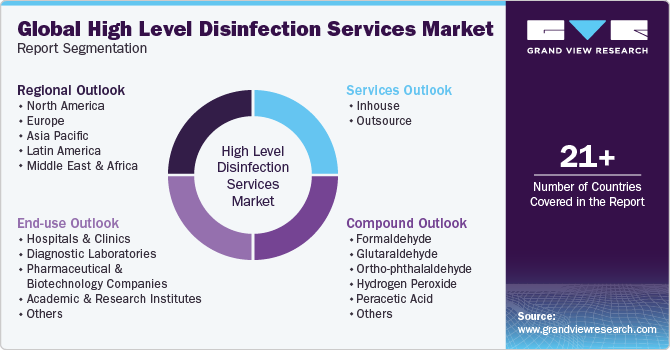- Home
- »
- Medical Devices
- »
-
High Level Disinfection Services Market Size Report, 2030GVR Report cover
![High Level Disinfection Services Market Size, Share & Trends Report]()
High Level Disinfection Services Market Size, Share & Trends Analysis Report By Services (Inhouse, Outsource), By Compound (Formaldehyde, Glutaraldehyde, Peracetic Acid), By End-use, By Region, And Segment Forecasts, 2023 - 2030
- Report ID: GVR-4-68039-372-8
- Number of Report Pages: 90
- Format: PDF, Horizon Databook
- Historical Range: 2018 - 2021
- Forecast Period: 2023 - 2030
- Industry: Healthcare
Market Size & Trends
The global high level disinfection services market size was valued at USD 23.97 billion in 2022 and is expected to grow at a compound annual growth rate (CAGR) of 7.3% from 2023 to 2030. The demand for high level disinfection services is increasing due to the growing incidences of Hospital-acquired Infections (HAIs), the rising prevalence of infectious diseases, and the burgeoning number of surgical procedures. HAIs are nosocomial infections that are more frequent in people undergoing long-term care, most notably surgical treatment. HAIs are most common in the elderly, infants, and patients with weakened immune systems.

The Aesthetic Society released its annual Aesthetic Plastic Surgery Statistics, and data showed that aesthetic plastic surgery procedures saw a significant increase in 2021. There was a surge in procedures for the face, breasts, and body. Aesthetic body procedures such as tummy tucks, buttock augmentation, and liposuction increased by 63% over 2020. Breast procedures like breast augmentation, breast lift, and breast reductions were up by 48%. Specialized face procedures, including brow lifts and face lifts, increased by 54% over the previous year. In simpler terms, more people underwent cosmetic surgeries for different body parts in 2021 compared to 2020.
A variety of causes, including a lack of proper hygiene in healthcare facilities, the use of catheters, and an overuse of antibiotics, might surge susceptibility to HAIs. These diseases may often lead to central line-related bloodstream infections, surgical site infections, urinary tract infections (UTIs) associated with catheters, ventilators, hospital-acquired pneumonia, and infections associated with clostridium difficile. The most common HAIs are surgical site infections (SSIs), methicillin-resistant Staphylococcus aureus (MRSA), enterococci bloodstream infections which are vancomycin-resistant, clostridium difficile, and central line-associated bloodstream infections.
According to the Centers for Disease Control and Prevention (CDC), out of six common infections, four showed an increase in prevalence in 2020 compared to the previous year. The largest increase was seen in Methicillin-resistant Staphylococcus aureus (MRSA), with a 14% rise. Ventilator-associated events (VAEs) increased by 12%, central line-associated bloodstream infections (CLABSIs) by 7%, and catheter-associated urinary tract infections (CAUTIs) by 5%. Thus, infections such as VAEs, CLABSIs, and CAUTIs saw a rise, but to a lesser extent.
The incidence of HAIs depends largely on the patient's immunity, infection prevention, and hygiene practices, and the presence of different infectious agents in the healthcare facility, leading to an upsurge in demand for infection control services. Hand hygiene with antiseptics, low-level disinfectants, and sterilization of gastrointestinal endoscopes with potent, high-level disinfectants are possible preventive measures.
Continuous product launches by key players offering high-level disinfection services are one of the major factors contributing to market growth during the forecast period. In March 2020, specialty chemicals company Lanxess launched Rely+On Virkon, a high-level disinfectant that is highly efficient against the coronavirus. Tests confirmed that Rely+On Virkon inactivates a closely related substitute of the rapidly spreading corona strain. Solvay’s peracetic acid-based liquid solution, PROXITANE, is effective against various fungi, bacteria, and viruses, including SAR-CoV-2, on clean and soiled surfaces.
Distribution agreements between key companies are also expected to boost the market for high-level disinfection services. For instance, Germinator and Arev Nanotec Brands are contracted to supply the ‘Genesis’ line of hypochlorous acid surface disinfectants to international public health initiatives supporting internally displaced people and refugees. Through the collaboration, Germinator offers Arev the global right to supply Germinator products to any refugee camp, UNICEF site, United Nations-run facility, or comparable facility.
The rising prevalence of chronic diseases such as diabetes, cancer, and other autoimmune diseases is expected to drive demand for high-level disinfectant services. Antimicrobial tolerance, rising adoption of unhealthy and sedentary lifestyles, obesity, and alcohol intake are all significant contributors to the rising prevalence of chronic diseases. According to the IDF Diabetes Atlas 2021 report, around 10.5% of adults aged 20 to 79 years have diabetes, but almost half of them may not know they have it.
Projections suggest that by 2045, about 1 in 8 adults, which is approximately 783 million people, will have diabetes, which is a 46% increase from 2021. Type 2 diabetes, which affects over 90% of people with diabetes, is influenced by factors like how people live, where they live, their genes, and more. In simple terms, many people worldwide have diabetes, which is expected to grow significantly in the coming years, with type 2 diabetes being the most common form.
Moreover, the rising geriatric population across the globe is the primary demographic suffering from chronic diseases. According to World Health Organization (WHO), by 2050, the world's population, which is 60 years of age and older, is expected to reach 2 billion. As a result, the increasing prevalence of chronic diseases has dramatically raised hospital admission rates.
Blankets, clean fluids, and appliances are necessities in hospitals and other care services. Thus, in such situations, high-level disinfectants and the environment efficiently serve the purpose, as they mitigate the risk of infection transmission among patients and increase care quality. Thus, the increasing prevalence of chronic diseases is projected to positively affect the market over the forecast period.
In addition, rising endoscopic procedures globally are expected to boost the demand for high-level disinfection services. For instance, a survey conducted by the National Center for Biotechnology Information (NCBI) from April 2020 to May 2020 found that around 2,069,447 endoscopic procedures were performed in a year. Similarly, according to the University College London, in April 2019, 110,584 endoscopic procedures were conducted. Endoscopic devices require major quality assurance for disinfection; hence, high-level disinfection services are used to disinfect these contaminated endoscopes, further propelling the market.
Furthermore, the outbreak of the COVID-19 pandemic had a positive impact on the high-level disinfection services market. For instance, as per the American Chemical Society, COVID-19 has increased the use of disinfectants worldwide. Regular disinfection of hospital equipment such as endoscopes to curb the spread of COVID-19 helped the high-level disinfection services market to advance.
Additionally, many key market players underwent strategic alliances such as mergers, acquisitions, partnerships, and geographic expansions to cope with the rising demand. For instance, in June 2021, STERIS plc completed the acquisition of Cantel Medical. This acquisition was expected to help the company tackle the increasing demand for high-level disinfection services. Such developments have helped boost the market during the COVID-19 pandemic.
Compound Insights
The glutaraldehyde compound segment accounted for the highest revenue share of around 22.5% in 2022. The segment is further anticipated to witness a considerable growth rate during the projection period. Aldehyde disinfectants are often used for endoscopic procedures and surgical unit reprocessing. Glutaraldehyde has for long been extensively used as a high level disinfectant for reusable surgical equipment in healthcare facilities.
The growing number of surgical procedures globally is expected to fuel demand for these services. Furthermore, hospital-acquired infections caused by excessive surgical unit reprocessing are expected to fuel demand for these solutions, causing the segment to rise profitably during the forecast years. Based on the type of compound, the high level disinfection service market is segmented into formaldehyde, hydrogen peroxide, glutaraldehyde, peracetic acid, ortho-phthalaldehyde, and others.
The ortho-phthalaldehyde compound segment is estimated to register the fastest CAGR of 8.6% over the assessment period. Ortho-phthalaldehyde is considered to be one of the most important high level disinfectants for sterilization. According to the National Center for Biotechnology Information (NCBI), when 0.55% ortho-phthalaldehyde (OPA) is compared with 2% glutaraldehyde for disinfection, it is found that with shorter contact time, OPA is more efficacious and cost-effective than glutaraldehyde for the disinfection of blades like laryngoscopes, as it is a ready-to-use formulation.
Services Insights
The outsourcing segment accounted for the largest revenue share of around 60% in 2022. Hospitals and clinical diagnostics centers usually prefer outsourcing disinfection services. Several benefits are associated with outsourcing, such as cost-saving, customized cleaning services, and usage of advanced technology. Furthermore, advances in global healthcare practices have resulted in hospitals outsourcing disinfection and sterilization services. This has provided opportunities for manufacturers of HLD equipment. Based on service, the high level disinfection services market is segmented into in-house and outsourcing.
The outsourcing segment is further expected to expand at the fastest CAGR of 7.55% during the forecast period. Outsourcing facilities are more prevalent in developed economies and are gradually infiltrating developing economies. In countries like the U.S. and a few countries in Western Europe, healthcare facilities are increasingly outsourcing Central Sterile Supply Department (CSSD) to meet infection control standards and top-quality management of complex surgical instruments.
Experts suggest that third-party sterilization and disinfection vendors will increase their focus on becoming end-to-end solution providers to cover cleaning, sterilization, tracking and managing workflow, CSSD layout design, and logistics services. This is expected to drive OEMs to embrace value-added services, including inventory management, CSSD integration, and equipment repair in their portfolio over the traditional service-centered approach. This would ensure third-party sterilization services are in direct contact with key decision-makers for better infection control by opening further avenues for market expansion.
End-use Insights
The hospitals & clinics segment held the largest revenue share of 38.8% in the global market in 2022. The rising prevalence of hospital-acquired infections is generating high demand for HLD in hospitals and other healthcare settings. Moreover, in several nations, the COVID-19 pandemic brought high level disinfection services to the mainstream, as part of bundled strategies, to control the virus.
According to the World Health Organization, in high-income countries, in acute-care hospitals, around 7 out of every 100 patients, during their hospital stay, may develop at least one healthcare-associated infection (HAI). This number increases to approximately 15 out of every 100 patients in low- and middle-income countries. On average, 1 in every 10 patients affected by HAI may, unfortunately, succumb to the infection.
Furthermore, the increased number of surgical procedures, stringent safety guidelines for both staff and patients, and medical waste disposal are driving the adoption of disinfection services in hospitals. However, in 2018, the Joint Commission organization in the U.S. held a survey and found that more than 50.00% of hospitals were noncompliant with sterilization standard IC.02.02.01, EP 2. Understanding the severity associated with HAIs, coronavirus infections, and several other infections, more hospitals are required to comply with HLD standards.
Moreover, proper hygiene and sanitation are needed to maintain a healthy environment in clinics. The spread of COVID-19 necessitates the implementation of preventive measures to limit the disease's spread; as a result, clinics are taking appropriate measures. These factors are expected to fuel the segment's growth during the forecast period by encouraging clinics to use high level disinfection services.

The market for high-level disinfection services is segmented into academic and research institutes, biotechnology and pharmaceutical companies, hospitals & clinics, diagnostic laboratories, and others, on the basis of end-use. The hospitals and clinics segment is expected to expand at the fastest CAGR of 7.6% during the forecast period. The need for optimal sterility and precision in testing procedures has increased the demand for disinfection equipment in diagnostic laboratories and research centers. Majorly due to rising infectious diseases, the number of people undertaking various tests has surged.
This situation has created a burden on diagnostic and pathology laboratories that necessitates using HLD solutions. They are commonly used in research laboratories to clean medical equipment and testing kits. In addition, the disinfection of infected medical instruments after use is an essential aspect of research centers' safety procedures to curb false results. The FDA has set guidelines to review research labs' safety and sterility practices, which is expected to boost segment growth.
Regional Insights
North America dominated the high level disinfection services market and accounted for the largest revenue share of around 35.5% in 2022. North America is projected to lead the high level disinfection services industry, owing to the outbreak of COVID-19, which has significantly increased the demand for surface disinfectants. The Environmental Protection Agency (EPA) of the U.S. released an updated list of EPA-registered disinfectant services that have been qualified for use against COVID-19 in March 2020, which included approximately 200 additional services and 40 new services.
Government initiatives such as awareness campaigns and discharge surveys can help combat HAIs; the US Department of Health and Human Services announced the Collaboration for Patients initiative to reduce HAIs. It focuses on HAIs that can be fatal, such as bloodstream infections and urinary tract infections brought on by catheters, ventilator-associated pneumonia, and SSIs.

Furthermore, the number of surgeries in the region has risen dramatically in recent years. According to the ASPS (American Society of Plastic Surgeons), more than 17.7 billion surgical and minimally invasive aesthetic operations were performed in the U.S. in 2018. As a result of both of these factors, North America is projected to have the highest revenue share in the market during the forecast period.
In Asia Pacific, the market for high level disinfection services is anticipated to witness the fastest CAGR of 7.62% during the assessment period, due to the growing cases of infection-transmitted diseases, such as COVID-19, exponentially in India, which is driving the demand for surface disinfectants. According to the World Health Organization, as of July 29, 2022, India logged 44 billion COVID-19 patients, leading to around 5,26,000 deaths.
A significant increase in the geriatric population that is susceptible to hospital-acquired infections is expected to propel the regional market growth. According to the United Nations Population Fund (UNFPA), by 2050, the number of older people is estimated to triple and reach 1.3 billion. In addition, the rising incidence of chronic diseases, rising number of surgeries, increasing prevalence of surgical site infections, and HAIs will contribute to the rising demand for HLD services, leading to regional market growth.
Key Companies & Market Share Insights
Key players are adopting different strategies such as partnerships, launching new services, and mergers and acquisitions to strengthen their position in the market. For instance, in the U.S., PROXITANE AHC has been approved for use against SARS-CoV-2 by the US Environmental Protection Agency (EPA). In Europe, PROXITANE solutions have been tested and proven effective against a wide range of viruses, including SARS-CoV-2, aiding a log 4 reduction of these viruses at tremendously low PAA concentration (0.3%), according to standard EN14476:2013. Testing has exhibited efficacy in both clean and dirty conditions.
In Brazil, it is available as a high level surface disinfectant for hospitals. In 2018, the commercial launch of Nanosonics' trophon2 high level disinfection (HLD) system for ultrasonic probe decontamination in the US and Canada was announced. The new tool gives medical practitioners a clever way to maintain compliance with the most recent standards for reprocessing surface and endocavity ultrasound probes while reducing exposure to potentially harmful substances.
Key High Level Disinfection Services Companies:
- Ecolab
- GE Healthcare
- Altapure
- Olympus Corporation
- Getinge
- STERIS
- Fortive
- Lifemed Technologies Pvt Ltd.
- Steelco S.p.A.
- Microchem Laboratory
- Metrex Research, LLC
- EcoFMR
- Jani-King International, Inc.
- Rentokil Initial plc
High Level Disinfection Services Market Report Scope
Report Attribute
Details
Market size value in 2023
USD 25.67 billion
Revenue forecast in 2030
USD 42.12 billion
Growth Rate
CAGR of 7.3% from 2023 to 2030
Base year for estimation
2022
Historical data
2018 - 2021
Forecast period
2023 - 2030
Report updated
October 2023
Quantitative units
Revenue in USD million and CAGR from 2023 to 2030
Report coverage
Revenue forecast, company ranking, competitive landscape, growth factors, and trends
Segments covered
Service, compound, end-use, region
Regional Scope
North America; Europe; Asia Pacific; Latin America; MEA
Country scope
U.S.; Canada; UK; Germany; France, Italy; Spain; Denmark; Sweden; Norway; Japan; China; India; Australia; Thailand; South Korea; Mexico; Brazil; Argentina; South Africa; Saudi Arabia; UAE; Kuwait
Key companies profiled
Ecolab; GE Healthcare; Altapure; Olympus Corporation; Getinge; STERIS; Fortive; Lifemed Technologies Pvt Ltd.; Steelco S.p.A.; Microchem Laboratory; Metrex Research, LLC; EcoFMR; Jani-King International, Inc.; Rentokil Initial plc
Customization scope
Free report customization (equivalent to up to 8 analysts' working days) with purchase. Addition or alteration to country, regional & segment scope.
Pricing and purchase options
Avail of customized purchase options to meet your exact research needs. Explore purchase options
Global High Level Disinfection Services Market Report Segmentation
This report forecasts revenue growth at the global, regional, and country levels and provides an analysis of the latest industry trends in each of the sub-segments from 2018 to 2030. For this study, Grand View Research has segmented the global high level disinfection services market report based on services, compound, end-use, and region:

-
Services Outlook (Revenue, USD Million, 2018 - 2030)
-
Inhouse
-
Outsource
-
-
Compound Outlook (Revenue, USD Million, 2018 - 2030)
-
Formaldehyde
-
Glutaraldehyde
-
Ortho-phthalaldehyde
-
Hydrogen Peroxide
-
Peracetic Acid
-
Others
-
-
End-use Outlook (Revenue, USD Million, 2018 - 2030)
-
Hospitals & Clinics
-
Diagnostic Laboratories
-
Pharmaceutical & Biotechnology Companies
-
Academic and Research Institutes
-
Others
-
-
Regional Outlook (Revenue, USD Million, 2018 - 2030)
-
North America
-
U.S.
-
Canada
-
-
Europe
-
UK
-
Germany
-
France
-
Italy
-
Spain
-
Denmark
-
Sweden
-
Norway
-
-
Asia Pacific
-
Japan
-
China
-
India
-
Australia
-
Thailand
-
South Korea
-
-
Latin America
-
Brazil
-
Mexico
-
Argentina
-
-
Middle East and Africa
-
South Africa
-
Saudi Arabia
-
UAE
-
Kuwait
-
-
Frequently Asked Questions About This Report
b. The global high level disinfection services market size was estimated at USD 23.97 billion in 2022 and is expected to reach USD 25.67 billion in 2023
b. The global high level disinfection services market is expected to grow at a compound annual growth rate of 7.33% from 2023 to 2030 to reach USD 42.12 billion by 2030
b. North America dominated the high level disinfection services market and accounted for the largest revenue share of 35.51% in 2022.
b. Some of the key players operating in the high level disinfection services market include Altapure, STERIS, Microchem Laboratory, Metrex Research, LLC. EcoFMR.Com, Rentokil Initial plc., Fortive Corporation (ASP), ECOLAB, GE Healthcare, OLYMPUS CORPORATION
b. Key factors that are driving the market growth include demand for high level disinfection services is increasing owing to the surge in hospital-acquired infections (HAIs), rising incidence of infectious disease, and increasing number of surgical procedures across the globe
Share this report with your colleague or friend.
![gvr icn]()
NEED A CUSTOM REPORT?
We can customize every report - free of charge - including purchasing stand-alone sections or country-level reports, as well as offer affordable discounts for start-ups & universities. Contact us now
![Certified Icon]()
We are GDPR and CCPA compliant! Your transaction & personal information is safe and secure. For more details, please read our privacy policy.
We are committed towards customer satisfaction, and quality service.
"The quality of research they have done for us has been excellent."





